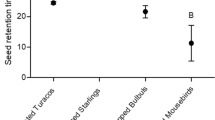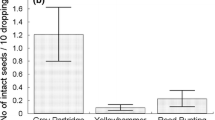Abstract
Few vertebrates are known to consume ferns regularly. Several species of mammals consume leaves to some extent but the consumption of fern spores is much rare. In Galicia (Northwest Spain) we studied the seasonal variation in the consumption of Culcita macrocarpa fertile leaves (i.e. with spores) in two populations (Capelada and Eume), assessed whether consumption rate increased with fern population size, and evaluated whether the consumer was a spore predator or a spore disperser. Consumption began in December and finished by mid February, and occurred before spore release, which happened later in Capelada than in Eume, probably influenced by differences in altitude. The consumer was identified as Apodemus sylvaticus by DNA analysis of its droppings and by capture of live animals. Throughout Galicia there was a significant increase in fern consumption rate as the population size of C. macrocarpa increased. Germination tests from droppings were carried out in 14 dishes but only in two dishes 1% and 0.3% of the spores germinated. Our results suggest that woodmouse can disperse spores of C. macrocarpa, although most of the spores were digested.
Similar content being viewed by others
References
Amigo, J., Norman, G., 1995. Identification of site-types important for rare ferns in an area of deciduous woodland in northwest Spain. Vegetatio 116, 133–146.
Arosa, M.L., Ramos, J.A., Valkenburg, T., Ceia, R., Laborda, H., Quintanilla, L.G., Heleno, R., 2009. Fern feeding ecology of the Azores bullfinch (Pyrrhula murina): the selection of fern species and the influence of nutritional composition in fern choice. Ardeola 56, 71–84.
Bañares, A., Blanca, G., Guemes, J., Moreno, J.C., Ortiz, S., 2003. Atlas y Libro Rojo de la flora vascular amenazada de España. Dirección General de Conservación de la Naturaleza, Madrid, pp. 310–311.
Brewer, S.W., Rejmánek, M., 1999. Small rodents as significant dispersers of tree seeds in a Neotropical forest. J. Veg. Sci. 10, 165–174.
Carpenter, K., 2006. Biggest of the big: a critical re-evaluation of the mega-sauropod Amphicoelias fragillimus cope, 1978. In: Foster, J.R., Lucas, S.G. (Eds.), Paleontology and Geology of the Upper Jurassic Morrison Formation. New Mexico Museum of Natural History and Science Bulletin 36.
Cellinese, N., Jarvis, C.E., Pichi Sermolli, R.E.G., Press, J.R., Short, M.J., Viciani, D., 1996. Threatened plants of Italy—Pteridophytes. Memorie dell’Accademia Lunigianese di Scienze “Giovanni Capellini” 66, 117–145.
Corbet, G.B., Southern, H.N., 1977. The Handbook of British Mammals, second ed. Blackwell, London.
Daniel, M.J., 1976. Feeding by the short-tailed bat (Mystacina tuberculata) on fruit and possibly nectar. N. Z. J. Zool. 3, 391–398.
Diaz, M., 1992. Rodent seed predation in cereal crop areas of central spain: effects of physiognomy, food availability, and predation risk. Ecography 15, 77–85.
Diaz, M., 1994. Variability in seed size by granivorous passerines: effects of bird size, bird size variability, and ecological plasticity. Oecologia 99, 1–6.
Dyer, A.F., 1979. The culture of fern gametophytes for experimental investigation. In: Dyer, A.F. (Ed.), The Experimental Biology of Ferns. Academic Press, London, pp. 253–305.
Edwards, G.R., Crawley, M.J., 1999. Herbivores, seed banks and seedling recruitment in mesic grassland. J. Ecol. 87, 423–435.
Farlow, J.O., 1987. Speculations about the diet and digestive physiology of herbivorous dinosaurs. Paleobiology 13, 60–72.
Forget, P.M., 1992. Seed removal and seed fate in Gustavia superba (Lecythidiaceae). Biotropica 24, 408–414.
García, F.J., Diaz, M., De Alba, J.M., Alonso, C.L., Carbonell, R., López De Carrión, M., Monedero, C., Santos, T., 1998. Edge effects and patterns of winter abundance of wood mice Apodemus sylvaticus in Spanish fragmented forests. Acta Theriol. 43, 255–262.
Hill, P.A., Lucas, P.W., 1996. Toughness and fibre content of major leaf foods of Japanese macaques (Macaca fuscata yakui) in Yakushima. Am. J. Primatol. 38, 221–231.
Hoch, G.A., Adler, G.H., 1997. Removal of black palm (Astrocaryum standleyanum) seeds by spiny rats (Proechimys semispinosus). J. Trop. Ecol. 13, 51–58.
Hoffmann, L.A., Redente, E.F., McEwen, L.C., 1995. Effects of selective seed predation by rodents on shortgrass establishment. Ecol. Appl. 5, 200–208.
Hulme, P.E., Hunt, M.K., 1999. Rodent post-dispersal seed predation in deciduous woodland: predator response to absolute and relative abundance of prey. J. Anim. Ecol. 68, 417–428.
Hummel, J., Gee, C.T., Südekum, K., Sander, P.M., Nogge, G., Clauss, M., 2008. In vitro digestibility of fern and gymnosperm foliage: implications for sauropod feeding ecology and diet selection. Proc. Biol. Sci. 275, 1015–1021.
Kiviniemi, K., Telenius, A., 1998. Experiments on adhesive dispersal by wood mouse: seed shadows and dispersal distances of 13 plant species from cultivated areas in Southern Sweden. Ecography 21, 108–116.
Marçal, W.S., Campos Neto, O., 1996. Condiçães nutricionais favoráveis à toxidez da samambaia nos bovinos. Rev. Pecuária Corte 61, 94–96.
Martínez-Cortizas, A., Pérez-Alberti, A., 1999. Atlas climático de Galicia. Consellería de Medio Ambiente, Xunta de Galicia, Santiago de Compostela, Spain.
Montgomery, W.I., 1989. Population regulation in the wood mouse, Apodemus sylvaticus. II. Density dependence in spatial distribution and reproduction. J. Anim. Ecol. 58, 477–494.
Nugent, G., Challies, C.N., 1988. Diet and food preferences of white-tailed deer in North-eastern Steward Island. N. Z. J. Ecol. 11, 61–71.
Nupp, T.E., Swihart, R.K., 1996. Effect of forest patch area on population attributes of white-footed mice (Peromyscus l eucopus) in fragmented landscapes. Can. J. Zool. 74, 467–472.
Ormonde, J., 1990. Pteridófitos endémicos, raros ou amençados das ilhas Macaronésicas. Fontqueira 28, 5–12.
Page, C.N., 2002. Ecological strategies in fern evolution: a neopteridological overview. Rev. Palaeobot. Palynol. 119, 1–33.
Parkes, J.P., 1984. Feral goats on Raoul Island II. Diet and notes on the flora. N. Z. J. Ecol. 7, 95–101.
Quintanilla, L.G., Pajarón, S., Pangua, E., Amigo, J., 2000. Effect of temperature on germination in northernmost populations of Culcita macrocarpa and Woodwardia radicans. Plant Biol. 2, 612–617.
Ramos, J.A., 1994. Fern frond feeding by the Azores bullfinch. J. Avian Biol. 25, 344–347.
Ramos, J.A., 1995. The diet of the Azores bullfinch Pyrrhula murina and floristic variation within its range. Biol. Conserv. 71, 237–249.
Ramos, J.A., 1996. The influence of size, shape and phenolic content on the selection of winter foods by the Azores bullfinch. J. Zool. 238, 415–133.
Reutter, B.A., Petit, E., Brunner, H., Vogel, P., 2003. Cytochrome b haplotype divergences in West European Apodemus. Mamm. Biol. 68, 153–164.
Schaefer, H.M., Schmidt, B., Bairlein, F., 2003. Discrimination abilities for nutrients: which difference matters for choosy birds and why? Anim. Behav. 65, 531–541.
Stevens, K.A., Parrish, J.M., 1999. Neck posture and feeding habitats of two Jurassic sauropod dinosaurs. Science 284, 798–800.
Suresh Kumar, R., Mishra, C., Sinha, A., 2007. Foraging ecology and time-activity budget of the Arunachal macaque Macaca munzala—a preliminary study. Curr. Sci. 93, 532–539.
Tellería, J.L., Santos, T., Alcántara, M., 1991. Abundance and food-searching intensity of Wood Mice (Apodemus sylvaticus) in fragmented forests. J. Mammal. 72, 183–187.
Telleria, J.L., Alcantara, M., Santos, T., 1992. Estudio comparado de las comunidades de aves y micromamiferos en campos de cereales del centro de España. Doñana Acta Vertebr. 19, 5–24.
Tryon, R., 1986. Biogeography of species, with special reference to ferns. Bot. Rev. 52, 117–156.
Wall, S.B., 1990. Food Hoarding in Animals. The University of Chicago Press, Chicago.
Wood, B., 2000. Room for nature? Conservation management of the Isle of Rum, UK and prospects for large protected areas in Europe. Biol. Conserv. 94, 93–105.
Zhang, Z.B., Xiao, Z.S., Li, H.J., 2005. Impact of small rodents on tree seeds in temperate and subtropical forests, China. In: Forget, P.M., Lambert, J., Hulme, P.E., Vander Wall, S.B. (Eds.), Seed Fates: Seed Predation, Seed Dispersal and Seedling Establishment. CABI Publishing, Wallingford, pp. 269–282.
Author information
Authors and Affiliations
Corresponding author
Rights and permissions
About this article
Cite this article
Arosa, M.L., Ramos, J.A., Quintanilla, L.G. et al. First report of fern (Culcita macrocarpa) spore consumption by a small mammal (Apodemus sylvaticus). Mamm Biol 75, 115–121 (2010). https://doi.org/10.1016/j.mambio.2009.05.009
Received:
Accepted:
Published:
Issue Date:
DOI: https://doi.org/10.1016/j.mambio.2009.05.009




